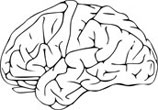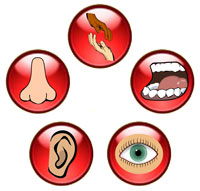  Fun Senses Facts for Kids Fun Senses Facts for Kids
Check out our senses facts for kids and enjoy a wide range of interesting information about the five main senses of touch, smell, taste, hearing and sight. Learn about other perceived sense in the human body, the different senses of various animals, how each of the five main senses work and much more. Read on for exciting facts about senses! | | |
The exact number of senses humans have is disputed due to the various definitions of what a 'sense' is. However, it is widely agreed that there are five main human senses: sight, hearing, taste, touch and smell.
Sight or vision is the ability of the eye to detect and focus on images of visible light with photoreceptors found in the retina of the eye. Electrical nerve impulses are generated for different colors, hues and brightness. The two types of photoreceptors are rods and cones. Rods are sensitive to light, while cones identify different colors. It is generally agreed that these two receptors are two senses, one sense for color and one for brightness, which together make up the overall sense of sight. Hearing is a sense that detects the vibrations of sound. Mechanoreceptors in the inner ear in the form of tiny bones and hair-like fibers, turn motion or sound waves from the air into electrical nerve pulses that the brain can then interpret. The sense of touch is activated by neural receptors such as hair follicles found in the skin, but also pressure receptors on the tongue and throat. The taste of food, is detected by sensory cells called taste buds located on top of the tongue. There are five basic tastes: sweet, bitter, sour, salty and savoury. Smell, like taste, is deemed to be a chemical sense. There are hundreds of olfactory receptors or sensory cells in our nasal passage, each of which will bind itself to a different molecular smell feature. Around 80% of what we think is taste is actually smell. Flavor, is a combination of taste and smell perception. Test this yourself by holding your nose closed the next time you eat something, can you taste it very well? Chances are you can't. Other perceived human senses are debatable but generally include, the ability to detect temperature, pain, balance and kinesthetic (which is the relative positions of our body parts - test this sense by closing your eyes and touching your nose with a finger). There are many internal body stimuli that may be perceived as senses too. For example, chemoreceptors for detecting salt and carbon dioxide concentrations in the blood and stretch receptors in the lungs which control our breathing rate. Compared to animals, humans have a quite weak sense of smell.
Animals have differences in how their receptors sense the world around them, for example dogs and sharks have a terrific sense of smell. While cats can see very well in dim light. Some animals have receptors in places that seem very unusual to us. Flies and butterflies, for example have taste organs on their feet, so they can taste anything they land on and catfish have taste organs across their entire bodies.
| | |  | | More Body Facts: | | | | | | | | | | | | | Senses Facts | | | | |
|
|